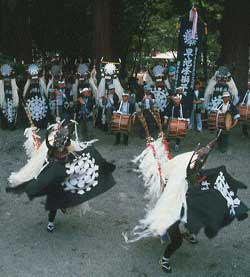
| Classification | Deer dance |
|---|---|
| name | Mineko Hayaike dance |
| Designated date | February 15, 1974 |
| Holding group | Mineko Hayaike dance preservation meeting |
| location | Tono City Tsukuha Ushicho-Kan |
watch video
Mejishikuru (Meji Shigurui)
Overview
As with the blue lion dances, it is a deer dance that does not have drums. The Kannogara (Zai) and the deer head are particularly impressive in the Tono region, and are called Kangara Gashi and Kanara Gashi. Kannagara is a thin ribbon that has been thinly scraped, for example. The figure carried on the back of a deer head with a wooden horn and a figure of watermark between them (the ornament) is the same as the other group. There were various kinds of figurines between the horns in the past, but in the Hayaike Mineko dance, they are now unified with the sword nine crest. About the beginning with 附, there is an old man who likes the play of 寅 2250 years (now treasure year) leaving 附 now in 馬 2600 local history ', 馬 遊 in 馬。 若 者 若 者 記念 記念 記念There is a statement that "we transmit deer dance". Currently, there are three transmissions of Kamiyanagi dance, Haruyama dance and Tozenji dance in Tono City's beef cattle, and it is customary to dedicate these three districts once every three years to Hayaikemine Shrine in Tono City Oide. So, it is called "Hayaikemine Shrine Role Lion." The Tono Go Hayaike Mineko Lion Dance Conservation Association was formed in 1973 by integrating deer dances from the three districts, and has reached the present.
Main performance place
Hayaikemine Shrine Regular Festival (July), Tono Festival (September)
